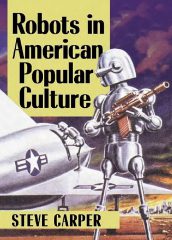The idea of building, commanding and using artificial creatures, based on mechanical components that would assist mankind doing anything from work, transportation or pleasure goes back to very early stories of creation such as the Gilgamesh epic. And mythology from ancient Greece and other regions.
 That idea also demonstrates man’s wish to become the creator of useful tools, such as the Golem or similar supernatural creatures; or what could be done with the help of automatic components, based on the principles that operate a clockwork.
That idea also demonstrates man’s wish to become the creator of useful tools, such as the Golem or similar supernatural creatures; or what could be done with the help of automatic components, based on the principles that operate a clockwork.
While technology developed and machines became more and more visible already before industrialization, the robot and already lived in fiction, as in Mary Shelley’s Frankenstein or E. T. A. Hoffmann’s “The Sandman.”
The many music machines, animated mechanical dolls and automatons of the 18th century provided the foundation of what was to become a mechanical man, a “robot” (a word derived from an obsolete Czech term for slave, or worker made popular in a 1921 American play).
Steve Carper follows certain origins of robot development in myth, history, and popular culture in general, that is, he looks for its origins in philosophy, religion, fiction and products of American popular culture as well in the history of technology. (For example, before WWI, they were part of fantastic literature, but never in the focus or a menace; after the horrors of the war, in part due to new technology and automation that killed millions, that changed.)
The book is organized and dominated by “six overarching motifs that have been repeated throughout the history of robots, in ways both overlapping and contradictory, giving homage to ancient and modern greats or reintroduced with apparent wonder.”
By splitting the title into “Robot Pre-Computer” and “Robot Post-Computer” chapters, the six motifs seem central to the chronicles and identification of the robot’s purpose: as servants, enemies, lovers, children, successors, or doubles.
Alongside the many purposes of the robots, many rather philosophical questions emerged over the decades, such as differences between clockwork automatons and steam men, boundaries between humanoids and machines, the ability to move around for being identified as robots, what identified a real robot, and so forth.
The public (and popular culture) seemed indifferent to the many variants of technical specifications. “They want the majesty of technological innovation, regardless of whether they see only a magic trick. The line between robots and automatons is blurry but as thick as The Great Wall of China compared to the distinctions among robots, clockwork figurines, steam men, ventriloquist dummies, and humans acting without expression on thousands of stages in thousands of cities over the past two centuries.”
The many robots in popular culture that receive attention here are mostly build as males and in fiction or film use male voices; they also are identified by “he,” rather than “it.” When in the post-war years film and TV became the main stages for robots, another principal feature received attention. “Artificial life that could pass easily for human brainstorm of movie and television producers, struck en masse in the 1960s by the realization that hiring humans was far cheaper and more reliable than building working humanoid machines. Plotlines followed; a nonhuman slipped into human society offered infinite possibilities. Besides, actors love playing dual roles with themselves.”
Depending on the respective decade and media (newspaper headlines, comic strips, cartoons, TV series or science fiction movie), the role of technology, scientific advancement, and the cooperation of man with robots in one of the identified six main themes, is what this book is all about. It is focused on the appearance and inclusion of the robot in American popular culture, including anything from boy’s novels, adventure stories, TV and film plots and naturally many (mostly sensationalist) press articles.
That coverage in many ways disregarded the development of contemporary robotic technology in reality, i.e. in industry or science, even though certain impulses led to advanced robot characters in popular culture.
And naturally the obsession with engineering, building, inventing and mechanization took over countless young (mostly male) readers already in the late 19th century who hungered for any article or sighting of novel mechanized man-like machines strongly promoted the idea of the robot and its many forms.
At times, mostly after the 1950, those creations were regarded as significant threats. “Today’s public image of computers as threats to our privacy while also serving as indispensable links to the world is an outgrowth of these earlier fears.”
After a brief but solid overview on the history of the imagined and real robot development, Carper specializes on the decades before and after WWII, which explains why there is a lot of text on Wall-E, Sparko, or Elektro. With a lot of care, particularly the many comic strips and funnies of the 1920 to the 1950s that feature robot friends and villains are introduced; all of what led to popular culture characters such as the Terminator, Data and C3PO.
Author Steve Carper is a Future Historian and science fiction expert, he maintains a companion website RobotsInAmericanPopularCulture.com with lots of illustrations that enlarge on the chapters.
A deeply entertaining and enlightening book on the history and “character” of strictly the mechanical/steam operated/clockwork machines that for several decades populated novels, movies and more and more of present day reality.
Review by Dr. A. Ebert © 2020
Steve Carper. Robots in American Popular Culture. McFarland, 2019, 301 p.
